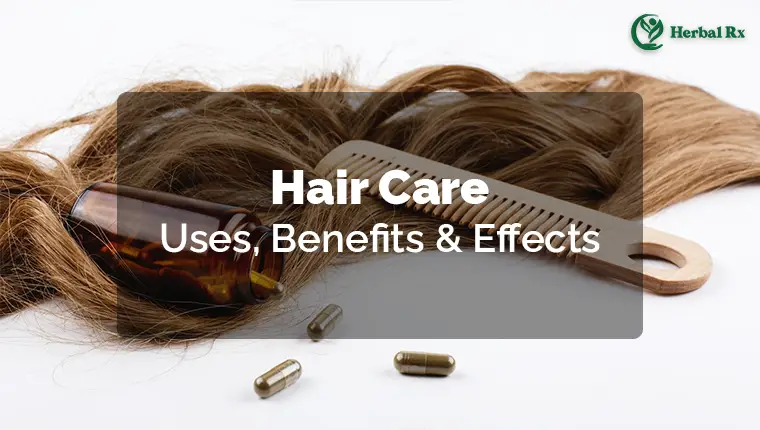Hair care ayurvedic capsule is an ayurvedic patented product for hair fall treatment. It claims to be very beneficial. It is a complete ayurvedic formula, which is precisely made using 6 selected herbs found naturally. According to ayurvedic texts and scriptures, these herbs work as sanjeevani for your hair. The hair care ayurvedic capsule not only protects and nourishes the hair but also prevents premature greying, dandruff problems, hair fall, and split ends, and checks loss of hair, sleeplessness, and headache (Gray, J., 2001).
Hair Care: Uses, Benefits & Effects
With the growing recognition of the value of herbs, it is surely time to examine the professional therapeutic use of these herbs.Get NowBenefits Of Hair Care
- It promotes the regrowth of hair.
- Hair Care helps in increasing the blood flow to the hair follicle which is the center of biological activities like hair growth and pigmentation.
- It also helps to activate new hair fibers, thus allowing the newly grown hair to be more strong, more vibrant, and capable of growing longer(Rosen, J., Landriscina, A. and Friedman, A.J., 2015)
Ingredients In Hair Care:
Extracts of herbs like Bhringraj, Amla, Brahmi/Mandukparni, and Methi seeds.
- Eclipta alba(Bhringraj) reduces the effect of alopecia, a hormonal issue that causes hair loss.
- Bacopa monieri(Brahmi) combats stress, which is the real reason for hair fall.
- Amla includes preventing and stopping dandruff and greying effects.
- Fenugreek (methi) contains lecithin, which functions as a natural conditioner and moisturizes your scalp and hair deeply. It also makes your hair stronger from its roots by providing high nourishment. Therefore, it controls hair fall, fights dandruff, and gives shine efficiently. (Gangadharan, G.G., 2010.)
Safety Information:
Should be taken under medical supervision(Araújo, L.A.D., Addor, F. and Campos, P.M.B.G.M., 2016).
Direction For Hair Care Usage:
- For adults- two capsules per day can take
- For children- one capsule per day can take
- recommended following the dosage instructions as prescribed your doctor(Nayak, B.S., Ann, C.Y., Azhar, A.B., Ling, E.C.S., Yen, W.H. and Aithal, P.A., 2017).
Things Need To Know
Considered it normal to shed between 50 and 100 hairs a day. But when the body sheds significantly more hair every day, a person has excessive hair shedding. In medical terms, the condition is known as telogen effluvium.
If you notice thinning of your hair, it might be hair loss. It’s seldom hard to differentiate between hair loss and hair shedding. But if you spot more hair strands on your pillow or comb, kindly consult your dermatologist.
If your major concern for hair loss goes beyond normal hair shedding or temporary telogen effluvium, you should take your doctor’s opinion. Hair coming out in clumps and leaving bald spots, and hair that’s growing in patches could be symptoms of an underlying health issue. Speak to your dermatologist or your physician and tell your symptoms if you need more guidance(Rushton, D.H., 2002.)
Factors increasing your risk of hair loss includes:
- Family history of balding
- Age
- Significant weight loss
- Certain medical conditions like diabetes and lupus
- Stress
- Poor nutrition(Talei, B., Shauly, O. and Gould, D., 2021).
Prevent hair loss using the following tips:
- Avoid hairstyles that create pull on the hair.
- Avoid high-heat hair styling tools.
- Don’t treat your hair chemically or bleach your hair.
- Use mild shampoos and hair products that are suited for your hair.
- Use a soft material brush made from natural fibers
- Try low level light therapy
It is simply not possible nowadays to rely on any random hair care products for proper maintenance and the best care of your hair. There are ample chemical-based hair products that claim many effective benefits. But they are obviously short-term and have other unseen or not noticeable side effects which may be harmful in a long run. This eventually can make your hair frizzy, damaged, easily breakable, dry, and dull. However, usage of ayurvedic hair products is anytime better than chemically designed ones as these Ayurveda-based hair care products will definitely help you to combat earlier mentioned hair problems(Huang, W.Y., Lai, S.F., Chiu, H.Y., Chang, M., Plikus, M.V., Chan, C.C., Chen, Y.T., Tsao, P.N., Yang, T.L., Lee, H.S. and Chi, P., 2017).
Hair Loss Reasons
- Hair loss can be caused by a variety of conditions, most commonly pregnancy, thyroid problems, and anemia. Autism spectrum disorders, polycystic ovarian syndrome (PCOS), and skin conditions including psoriasis and seborrheic dermatitis are among others, according to Rogers.
- Androgenic alopecia is the most common cause of male hair loss (also known as androgenetic alopecia or male pattern baldness). The scalp becomes more sensitive to the hormone dihydrotestosterone (DHT) in this condition, shortening the hair growth cycle and reducing hair follicle output. As a result, fewer hairs develop in some regions, such as the top of the head and over the temples, over time. The hairs that do grow are thinner and more easily broken than they were previously.
- An inherited disease that occurs with aging is the most common cause of hair loss. Androgenic alopecia, seldom known as male-pattern type baldness or female-pattern type baldness, is a disorder that affects men as well as women.
- Getting medical help is necessary for dealing with the issues of male pattern hair loss and poor self-esteem.
- Don’t ignore these crucial things. The sooner you address hair loss symptoms, the more likely you are to avoid permanent outcomes. Speak with a doctor right now to start your journey to a fuller head of hair(Almohanna, H.M., Ahmed, A.A., Tsatalis, J.P. and Tosti, A., 2019).
Attention
- Excessive hair loss from the scalp is often called baldness. The most common cause of baldness is genetic hair loss as people get older. Some people may leave their hair loss untreated and neglected. Hairstyles, makeup, caps, and scarves may be used to conceal it. Some choose one of the available treatments to prevent further hair loss or restore hair growth.
- Consult your doctor about the cause of your hair loss and other treatments before considering hair loss treatment.
- On top of the skull, there is a gradual decrease. This is the most common type of hair loss, which occurs when people grow older. Hair begins to fall out near the hairline on the forehead in men. In most cases, women’s hair has a partial extension. Hair loss is a common cause of hair loss in older women (frontal fibrosing alopecia).
- Bald or rounded areas. On the head, chin, and forehead, some people lose their hair in a round or bald spot. Before the hair comes out, your skin may be uncomfortable or unpleasant.
- Sudden hair loss. Hair loss can be caused by physical or mental damage. When you comb or wash your hair, or even after a little pulling, a few strands of hair may come out. This type is temporary.
- Hair loss throughout the body can be the result of other medical conditions, such as cancer chemotherapy. Hair usually grows on its own.
- Scales that stretch the entire scalp. This is a sign of the ring. Broken hair, redness, swelling, and itching are all possible symptoms (Springer, K., Brown, M. and Stulberg, D.L., 2003).




